Chicken stock is one of the essential ingredients in Chinese cooking. It uses a minimal amount of fresh herbs, such as ginger and scallion, to bring out the flavor of the chicken without adding too much character to the stock. The finished chicken stock is full of gelatin and has a soothing aroma and a buttery texture.
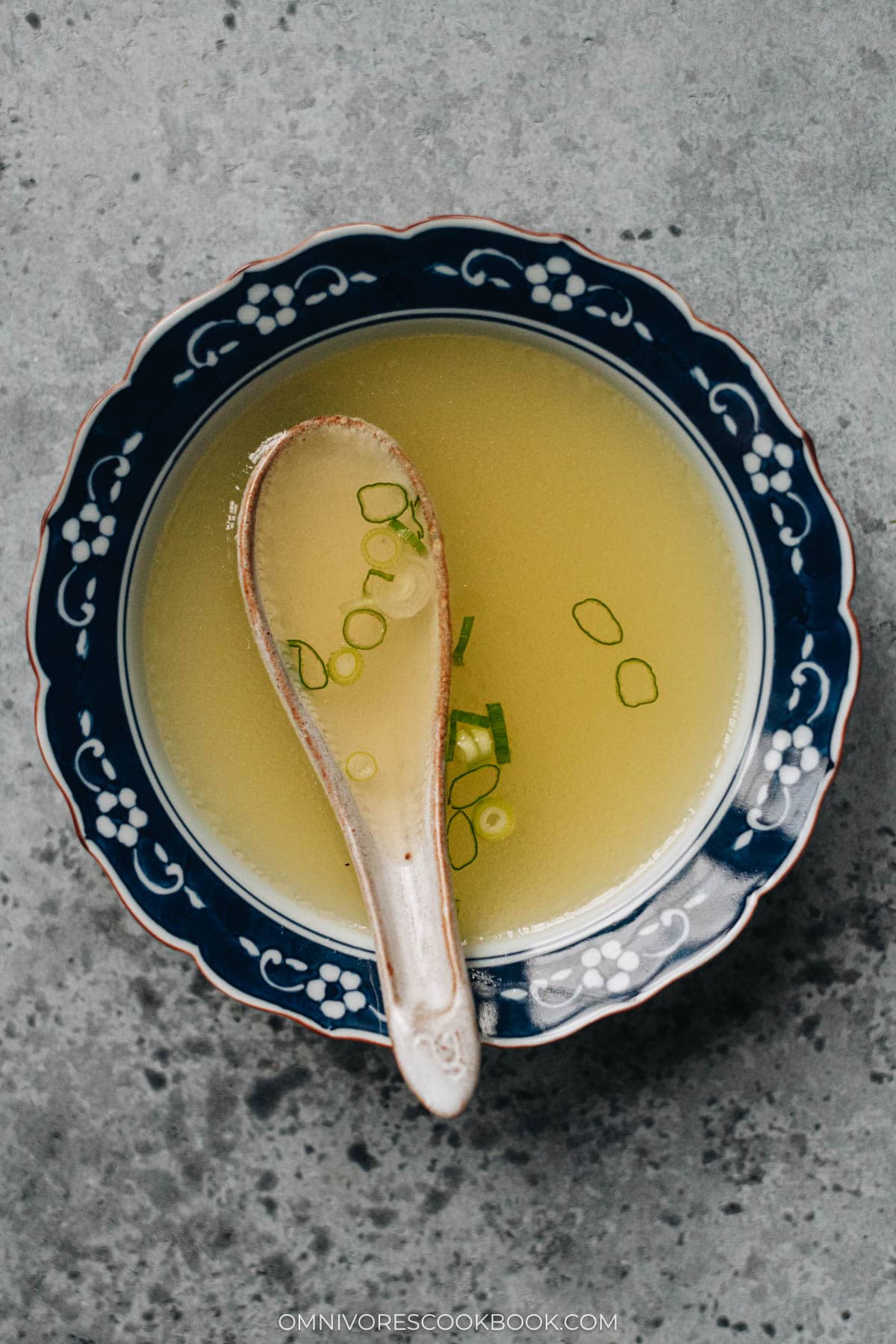
What is Chinese chicken stock
Cooking chicken stock is a very common practice in Chinese cuisine and one of the most important ingredients for Chinese restaurants. No matter whether it’s used for chicken noodle soup, wonton soup, wonton noodle soup, or to be added into stir fry sauces, homemade chicken stock adds a flavor far superior to that of canned stock and is free of additives.
Moreover, homemade chicken stock is slowly simmered until the soft connective tissue from the chicken bones melts, creating a velvety soup texture that is full of gelatin. Unlike the store-bought stock that is quite thin, homemade chicken stock has a rich texture that lingers on your tongue. You can even simply enjoy it by itself with a pinch of salt.
Different from a Western-style chicken stock, homemade Chinese chicken stock uses minimal aromatics without any vegetables. The ginger and scallion help eliminate any unpleasant scent of the meat and bring out its flavor without adding too much sweetness to the stock.
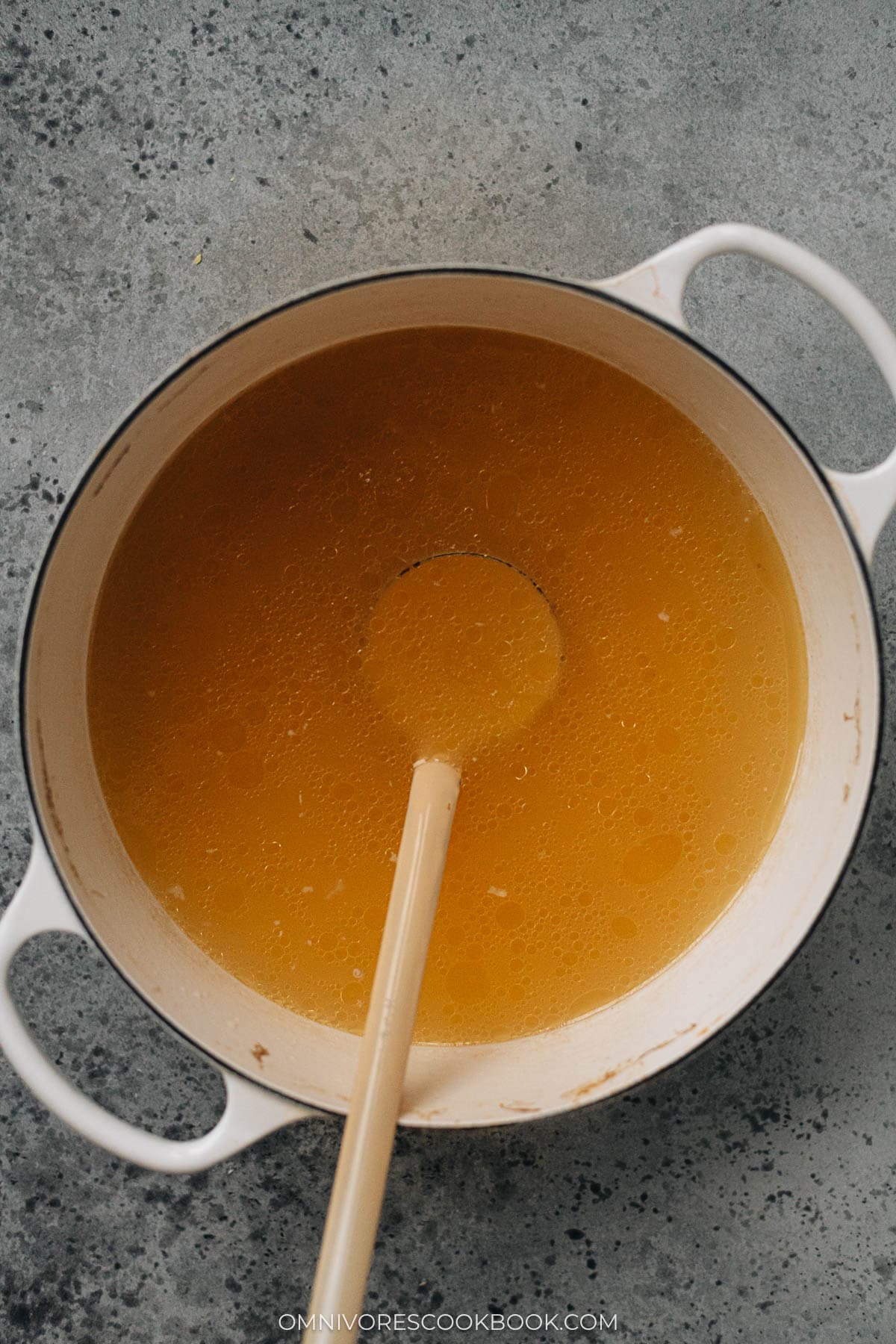
Chinese chicken stock ingredients
Which part of the chicken to use
There are many ways to make Chinese chicken stock, depending on your goal and the availability of ingredients.
Whole chicken – It’s a very common way that home chefs in China use. The chicken is kept whole if it’s a small bird. And it’s taken apart into bone-in pieces for larger birds. For larger birds, lots of home cooks like to remove and reserve the breast meat for making chicken stir fries, since it doesn’t add too much to the broth.
Chicken bones – It’s a very economical way to make chicken broth. The only issue is, it takes a long time to make a small amount of chicken stock. Check out my recipe on chicken stock made with leftover chicken bones.
Assorted bone-in pieces – It is the approach commonly used in Chinese restaurants and in this recipe, because it costs less than using a whole chicken and creates a very good result. I used 1 part chicken feet for the gelatin and 3 parts chicken bone-in thigh for the flavor. After three hours of simmering, it results in the most buttery chicken broth that is a joy to sip by itself.

Why cured ham in chicken stock?
Most Chinese restaurants use a master stock (高汤, Gao Tang) for the base of their soup, stew and noodle broth. The master stock can be a pork or chicken stock, or even sometimes a combination of both. Every restaurant has their own practice, but this method was shared by one of my team members who previously worked in Hong Kong restaurants. This is a restaurant secret to creating an extra rich chicken stock for their wonton soup.
Originally, the recipe called for a small piece of Jin Hua Ham (金华火腿), which is a type of Chinese cured ham that is similar to Iberian hams (Jamón ibérico or serrano). But since it’s quite difficult to source it in the US, I called for prosciutto as a substitute. Prosciutto has a different taste, but it won’t make a huge difference in this recipe.
Since prosciutto is quite pricey, look for prosciutto ends or scraps at your local market. They’re much cheaper and will be your best bet.
That being said, it’s totally OK to skip this ingredient and still make a great chicken stock.
How to make Chinese chicken stock
First, blanch the chicken feet to get rid of any gamey taste. Thoroughly wash the chicken feet with running tap water after the blanching and clean them thoroughly.
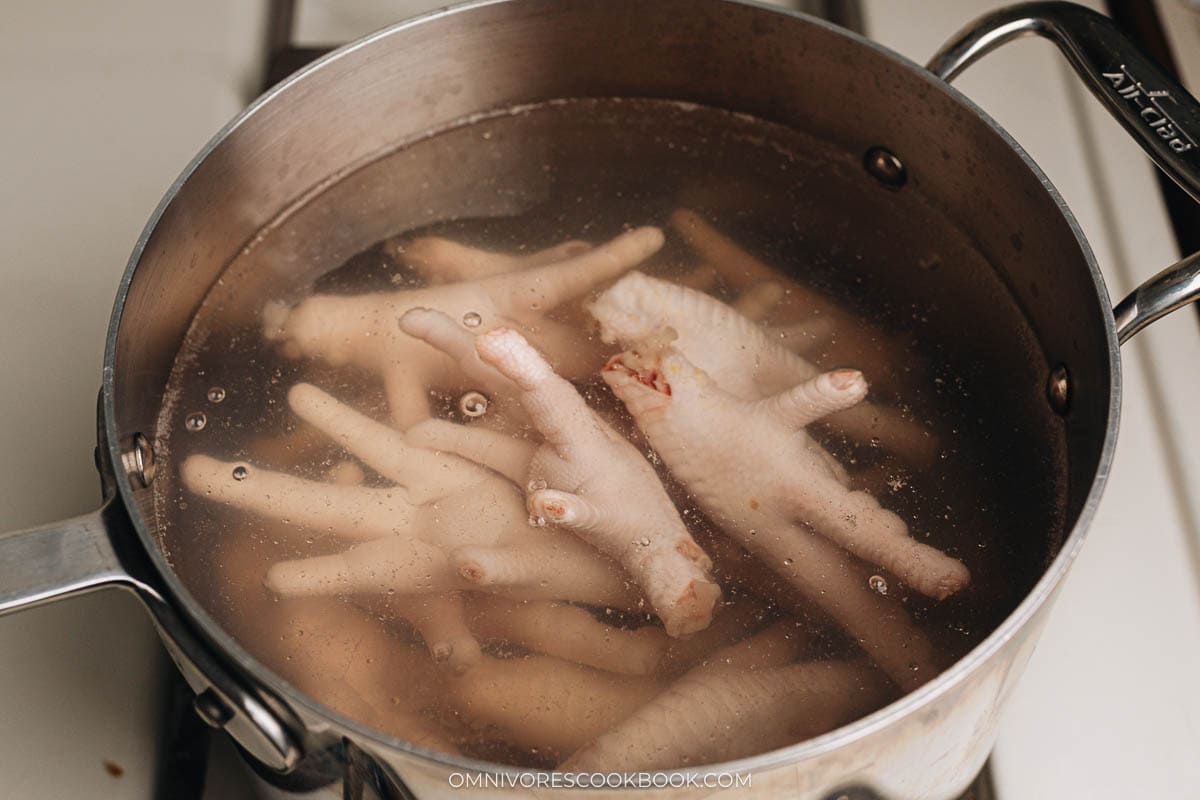
Then combine all of your ingredients in a large heavy pot, ideally a dutch oven. It creates a better tasting broth if you use a heavy pot with a lid that seals well.
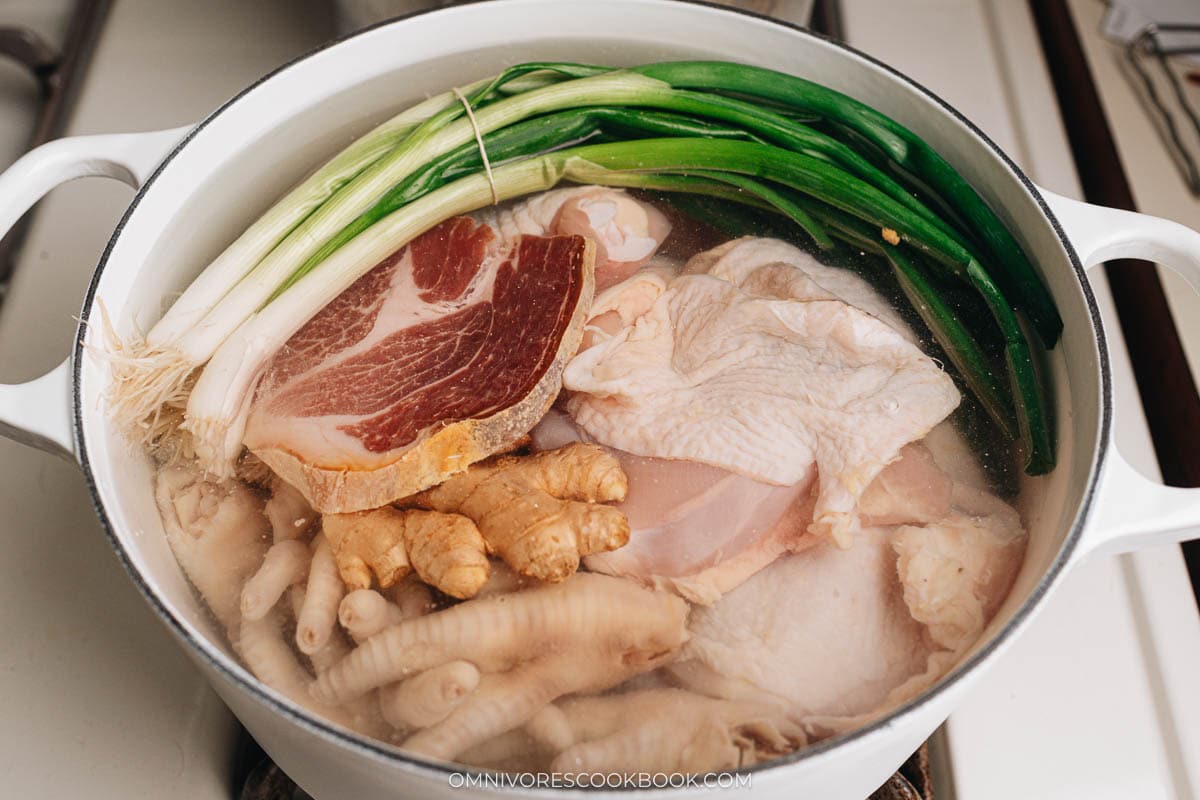
After bringing the water to a boil, make sure to skim off any foam floating on the top so you will end up with a clear chicken broth.
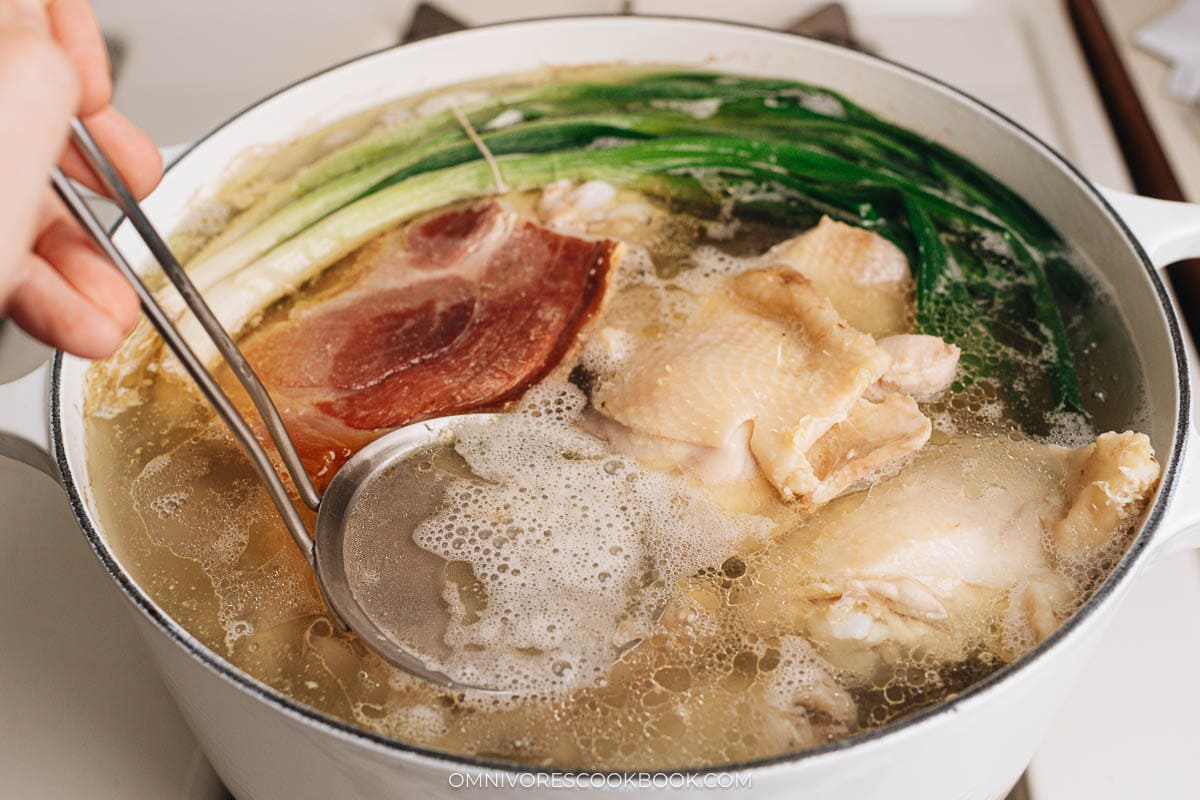
Lastly, all you need to do is simmer the broth with the cover on for 2.5 to 3 hours, until you get a delicious pot of chicken stock that smells heavenly.
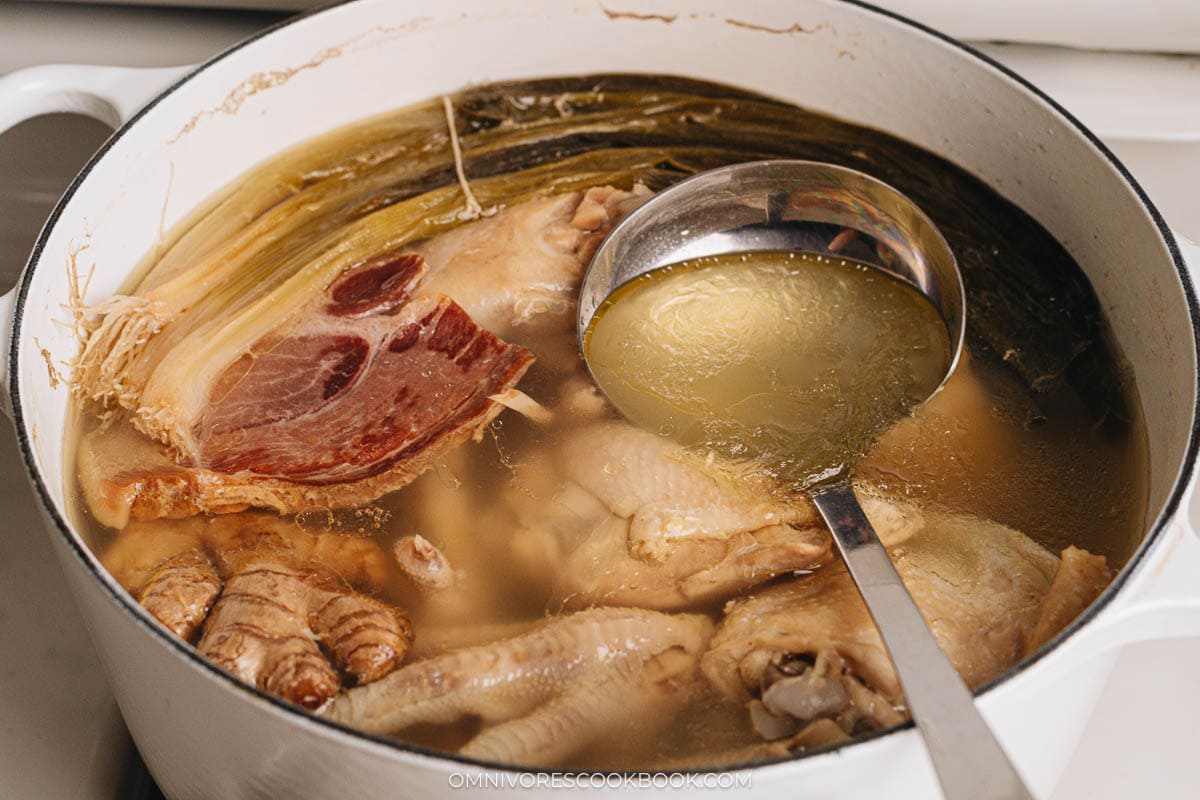
You can skim off the oil from the top, or refrigerate the stock and remove the coagulated fat once the stock is chilled.
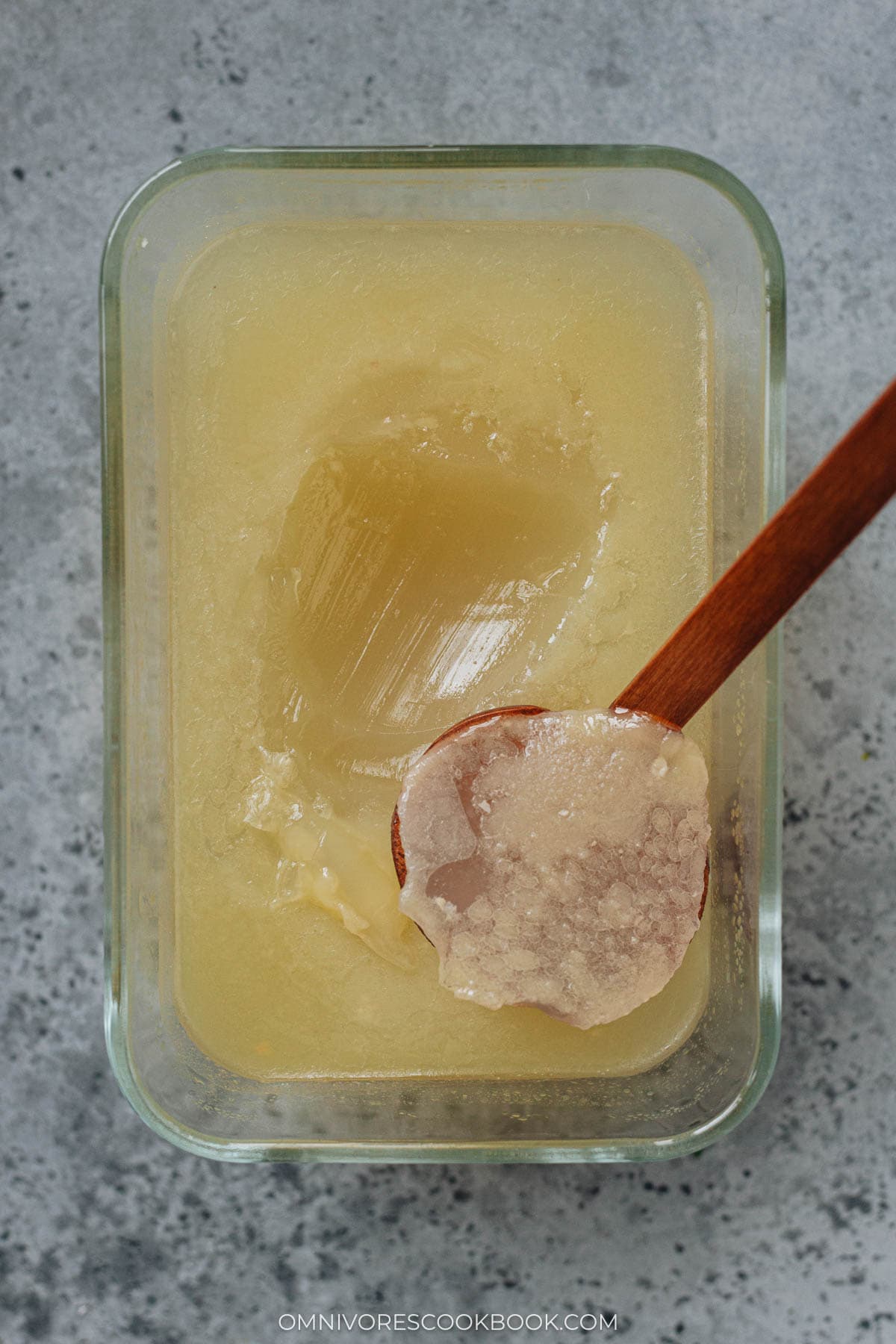
How to serve and use chicken stock
You can use the stock in noodles, soups, stews or stir-fried dishes.
- Wonton soup – The best way to enjoy chicken stock is to use it in wonton soup or wonton noodle soup. I promise you that if you follow my recipe, you will get a great wonton noodle soup that tastes better than some restaurant versions.
- Chicken soup – You can simply add a pinch of salt and sliced green onion to enjoy the chicken stock by itself.
- Noodle soup – Another very simple way to enjoy the stock is to use it to make a simple noodle soup such as soy sauce noodles.
- As a part of the stir fry sauce – You can also use this stock in any of my stir fry recipes that call for chicken stock or broth.
You’d be surprised how much your dishes are enhanced by simply using homemade chicken stock.
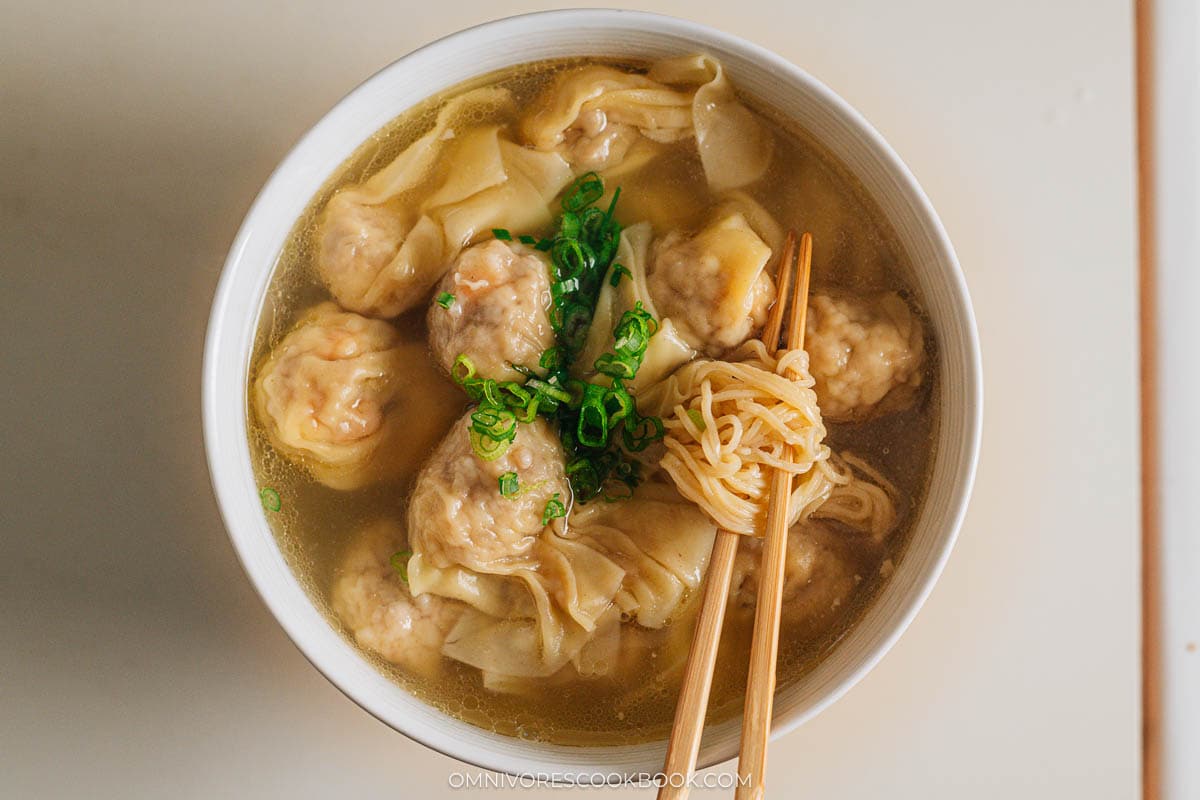
What to do with the leftover chicken meat
Once the chicken stock is made, the bone-in chicken thighs will be super tender but unfortunately will not have much taste left in them. I still save them because it’s quite easy to use the leftover chicken meat to put together a quick meal.
I usually remove and discard the chicken skin and bones, save the meat in small portions in ziplock bags, and freeze them. You can use the chicken in a sandwich, salad, soup, or throw it into fried noodles.
My favorite way to use the leftover chicken is – dust the chicken with a very thin layer of cornstarch and add salt and pepper. Pan fry the pieces until golden crispy. You can serve them with any kind of sauce you prefer. This is one of my favorite snacks that I can enjoy with rice or noodles.
Chinese Cooking Made Easy
Are you new to this website? This free email series is a great place to start. I’ll walk you through a few of my most popular recipes and show you how and why they work. You’ll quickly start to cook better Chinese food in your own kitchen.
Watch video
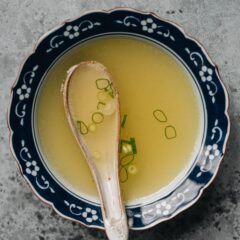
Chinese Chicken Stock
Ingredients
- 1 lb Chicken Feet (Footnote 1)
- 3 lbs Chicken bone-in pieces (*Footnote 2)
- 2 oz prosciutto (or other cured ham) (optional)
- 6 green onions
- 1 ” ginger , large sliced
- 10 cups cold tap water
Instructions
- Use a pair of poultry shears to clip off the nails from the chicken feet. Add the chicken feet into a big pot and add enough cold water to cover. Heat over medium-high heat until brought to a boil. Boil for 10 minutes. Then drain and discard the boiling water. Wash the chicken with running tap water thoroughly, then transfer to a large pot or dutch oven (5 1/2 qt or bigger).
- In the same pot, add the chicken pieces, prosciutto if using, green onion and ginger. Pour in the water.
- Heat over medium-high heat until boiling. Boil for 10 to 15 minutes while using a colander to remove the brown foam from the top, until the broth is clear. Turn to medium-low heat and cover. Simmer for 2.5 to 3 hours.
- Remove the chicken pieces and all the aromatics. If using the stock immediately, use a strainer to remove the chicken fat from the top. Alternatively, you can store the stock in the fridge. Once the soup is chilled, you can easily remove the chicken fat that’s coagulated on top.
- Now you can enjoy the stock by itself, use it in cooking, or store it for later use. Store it in the fridge for 3 to 4 days, or in the freezer for up to 3 months. (*Footnote 4)
Notes
- The gelatin from the chicken feet will melt into the soup, creating a nice jelly texture once the chicken stock is cooked and chilled. The feet are also quite cheap to obtain.
- I used skin-on bone-in chicken thighs. You can use other bone-in chicken cuts such as wings. It’s possible to use cheaper bone parts such as chicken back and neck. Bone-in cuts will create a nicer stock.
- Chinese restaurants use cured ham (金华火腿, Jin Hua Huo Tui) in the chicken broth to add another dimension of flavor. The closest cured ham outside of China is jamon iberico or prosciutto, which can be quite pricey. Sometimes you might be able to purchase prosciutto ends or prosciutto scraps, which are much cheaper. I highly recommend adding a small amount of it to further boost your chicken stock.
- I like to use a Zwilling vacuum sealer and container, which prolongs the stock’s shelf life in the fridge up to 2 weeks. You can also freeze the stock using an ice tray, so you can easily take out a small portion at a time for stir fries.
Nutrition

Did you make this recipe?
I’d love to hear how it turned out for you! Please take a moment to leave a 5-star rating ⭐️ and share your thoughts in the comments further down the page. It really helps others discover the recipe too.
The blog post was published in Nov 19, 2014 and updated in Jan 9, 2025.

Lauren
Is it possible to make this in an instant pot? I’m Chinese American adopted from China and I love Chinese chicken broth but have always felt it was too labor intensive to make
Maggie Zhu
Yes you can! I would only use 8 cups water if using Instant Pot, because you won’t lose much liquid during the cooking. I would still follow the recipe until step 3 (it’s important to blanch the chicken feet to get a better flavor), skim the brown foam from top, then cook on high for 1 hour.
Peggy
Followed recipe exactly. Came out perfectly delicious. Never cut nails off a chicken before! Will be my go to broth forever.
Maggie Zhu
So happy to hear you like the recipe! It’s one of my favorites too 🙂
Juli
I am planning on trying this recipe this week. I would think this would be great just on its own! To warm up on a winter day or if you are not feeling well.
Maggie Zhu
Yes the chicken broth will taste great on its own, with a small pinch of salt. My mom always made it for me when I was feeling under the weather. Happy cooking!
Dale Tucker
On Monday, this week, I made this stock, using a whole chicken we’d bought on sale and had in the deep freeze. Unfortunately, there are no Asian markets near where I live so I was unable to buy a Chinese scallion as called for in the recipe. But at my local supermarket I was able to purchase a small leek and a bunch of large green onions. I used half of the leek and half of one of the large green onions and a slice of fresh ginger which I put in the pot with my thawed and thoroughly rinsed chicken and followed the recipe instructions otherwise. In three hours it was done. I gleaned 1.75 lbs of tasty meat which literary fell from the bones and got a bit over 3 quarts of delicious broth, with some of which I made Maggie’s egg drop soup. This is a very easy and useful recipe and I’m so glad to have it. I’m one of those cooks who understands how useful good stock is to have on hand but was always discouraged when a recipe called for 15 dollars worth of ingredients to make more stock than I could keep in my fridge. This recipe is for me. Thank you, Maggie. You’re terrific.
Jeannie
4th time to try writing you. Website keeps reloading. Grrr!
LOVE THIS RECIPE!!!
2nd time making it.
What is your thoughts on the nutritional value of broth cooked low & long?
I ask because you mentioned nutritional value of ingredients.
Tina
Maggie, thank you for this recipe! It’s been life-changing – no exaggeration. I’ve made it practically every week for months now, sometimes with the addition of garlic and star anise. It’s great for quick dinners. I just skim off the fat, sauté some greens and vegetables in it, then pour over the stock and chicken pieces to reheat. Great comfort food that still meets my macros! Thank you again!
Melody
So no salt? I’m going to try to follow the recipe, but… no salt. Okay. I’ll try it. I suppose I could add salt later if I need to. No salt… (Over-salted American palate goes into anxiety mode trying to imagine stock with flavor and no salt)
Maggie
Hi Melody, yes you can always add salt later. I rarely add salt at the beginning of cooking but I do season the stock according to my taste later on, when I use the stock in a dish or before drinking it.
Anuradha
Looks great! Would love to try it! We don’t like the skin on chicken. Can we do this with skinless and chopped pieces?
Sharon
Hi, in this recipe, do we use up the head and neck of the chicken as well? I usually use the feet but discard the head and neck. Thanks 🙂
Master Cookatoor
I always add Mirin and Soysauce, Imo it makes it even better, even so it slightly spoils the “all Natural” charackter of the dish. I just wanted to share my ideas.
Maggie
Oh yeah, adding mirin and soy sauce totally makes sense! I don’t add these ingredients to my stock but I do add Shaoxing wine and soy sauce to my chicken soup. Yum!
Penny
Kia ora from New Zealand! I made this stock today and it is amaaazing. I am sick at the moment so it is just what I had in mind for the base of a nice chicken noodle/wonton soup. Looking forward to testing our=t some of your other recipes as well, thanks!
Nagi@RecipeTin Eats
Maggie! This is GOLD! I have always wondered why the soup in Chinese restaurants is so much nicer than just adding chinese chicken stock into store bought chicken broth or water. This is an essential! And you really end up with 3 things: stock, cooked chicken AND fat for Chicken rice!! I love this!
Maggie
Exactly! The fat part is quite essential for cooking various Chinese dishes, like stew or stir-fry.
The soup in Chinese restaurant is even more complicated than this sometimes. They blend into dried ham (a Chinese one, a bit close to prosciutto), dried bamboo or even pork bone to make the soup base. I always try to make my recipe healthier, but sometimes you can’t skip the fat to get a great dish! 🙂
kbsalazar
My family isn’t Chinese, but we share love for real chicken soup made from whole chickens.
In answer to the comment above on what to do with the post-soup chicken – We pull the bird out before it’s stewed to pieces, brush it with chicken fat from the top of the soup pot, sprinkle on paprika, garlic powder, salt, pepper, onion powder, or whatever other spice/herb tickles our fancy, then roast it in the oven just long enough to crisp the skin. Splitting the chicken prior to stock-making lets you do this quicker without flipping the chicken over mid-roast to crisp the second side. The resulting dinner is soup made from the stock (reduced after the chicken is removed, to concentrate flavor), often with matzo balls or vegetables and noodles or rice; followed by the chicken, with any standard veggie or starch side dishes.
Roast chicken done this way will be softer, and less intensely chicken than a dry roasted bird, but it will be totally edible, and fall off the bone tender. Kids especially like it.
Maggie
Hi Kbsalazar, thanks for stopping by and sharing your knowledge! We usually eat the chicken with dipping sauce; use it in noodles, fried rice or conjee; or season it and grill on stove top. I never tried to roast the chicken, but it sounds really nice! I’d love to try out your method next time! 🙂
Lisa @ Healthy Nibbles & Bits
My mom makes chicken stock all the time, and I know that the broth makes soups taste way better. I need to try this some time! Do you have any suggestions on what to do with the chicken after you’ve cooked the broth (aside from just chopping it up and eating it straight away).
Maggie
Hi Lisa, I have a very brief note attached at the end of the recipe about using the chicken.
Basically, you should take the chicken from stock when it turns very soft and before its flavor washed out. For a normal chicken or chicken that is smaller in size, it usually takes 2 hours. But when I used “free range old hen”, the chicken took a bit longer than two and half hour to get very tender. Now you can transfer the chicken to a plate or working surface to cool off.
When you can handle the chicken, you have two options.
(1) Separate the chicken into smaller pieces, dip with a batter that is seasoned with salt and pepper, then deep fry the chicken until crispy. (It’s very delicious but quite messy.)
(2) Tear the chicken meat from the bone, season with salt and pepper, coat a thin layer of flour and grill on stove top until crispy.
(3) To eat plain, I usually make this dipping sauce to serve with: 1 Tsp light soy sauce + 1 Tsp black vinegar + 1 teaspoon sugar. It’s very tasty!
(4) The other ways include adding the chicken into fried rice, noodles, conjee or soup.
Hope you find this useful 🙂